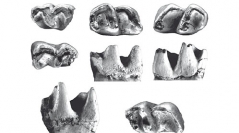

 Geodiversitas
28 (1) - Pages 137-173
Geodiversitas
28 (1) - Pages 137-173The fossil macromammal locality of Alcoy (province of Alicante, Spain) is known since the middle of the 19th century. Ever since then, its age has been disputed as the latest Miocene or the earliest Pliocene. There are several sites in the area that yielded micromammals: Alcoy-Barranco, Alcoy-N, Alcoy-4B and Alcoy-2, which range in age from MN13 to MN15, that is from the latest Miocene to the early Pliocene. The large mammals, however, all come from Alcoy-Mina, an old lignite mine. We have revised this material kept in various European collections. The faunal list is the following: Agriotherium insigne (Gervais, 1859), Ursus boeckhi Schlosser, 1899, Anancus arvernensis (Croizet & Jobert, 1828), Hipparion crassum Gervais, 1859, Dihoplus schleiermacheri (Kaup, 1832), Sus arvernensis Croizet & Jobert, 1828, Alephis boodon (Gervais, 1853) and Tragoportax sp. Ursus boeckhi and Tragoportax sp. are recognized for the first time in Alcoy. Although in earlier works two species of Hipparion were noted, we recognize only one species. Several specific (Agriotherium insigne, Sus arvernensis) and generic (Dihoplus schleiermacheri, Alephis boodon) determinations changed. The taxonomical revision of this material allows determination of the biochronological position of the macromammal locality of Alcoy-Mina that is placed in the early Pliocene (Ruscinian, MN14).
Mammalia, Carnivora, Artiodactyla, Proboscidea, Alcoy, Spain, Pliocene, Ruscinian, biostratigraphy